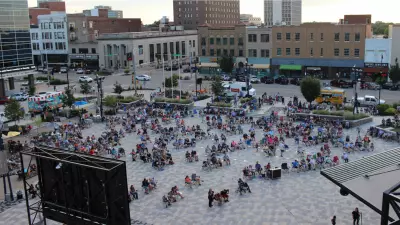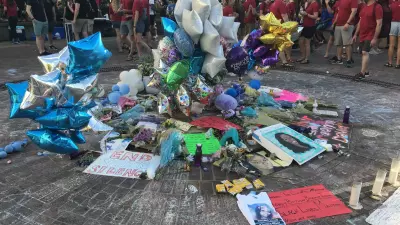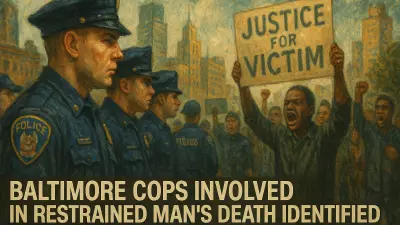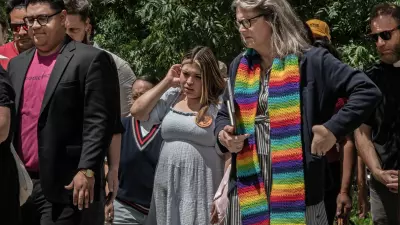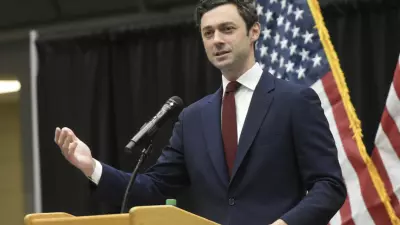Every year from November to March, visitors gather in Carroll Creek Park in downtown Frederick, Md., to catch a sparkling lineup: a series of lighted sailboats.

Businesses sponsor the “Sailing Through the Winter Solstice” boats and take part in festivities at the park, which began as a solution to the city’s flooding problem in the late 1970s. In warmer months, water lilies are incorporated as a complement to the 1.3-mile creek — really a flood control system with underwater conduits that has been beautified with brick walkways, fountains, and an amphitheater over the past 20 years.
The park has helped the city’s visitor center position the downtown as an entertainment hub, complete with a central business district, gathering spaces for events, and ample foot traffic. It’s also the kind of downtown experience that some postindustrial cities and towns are angling to manufacture to drive visitors and residents to historic streets and storefronts in the post-COVID era.
With long-term investments in downtowns already in motion, cities such as Frederick also are well-positioned to benefit from evolutions in how and where people live, according to Jim Russell. He is a geographer based in the Washington, D.C. area, who researches how global economic change impacts communities and neighborhoods.
“When people think of suburbia or exurban sprawl, they’re either thinking of something really rural or a sea of single-family homes,” he said. “The exurban sprawl, and wealth and concentration of people with a college education in the D.C. area is now fanning out and finding these little gems that are more in play because of remote work capabilities.”
In turn, when home prices rise in Frederick and similarly situated places, locations such as Harrisonburg and Winchester in Virginia’s Shenandoah Valley become the next tier of attractive cities, Russell said. People who may work in D.C. but need to show up in person only a couple times a month can justify moving a little farther out for a more affordable lifestyle that still offers some downtown amenities.
“A lot of those places in western Virginia have fallen on hard times — a lot of furniture manufacturing and food manufacturing areas — but you can go up and down the Shenandoah Valley and see the same good bones.”
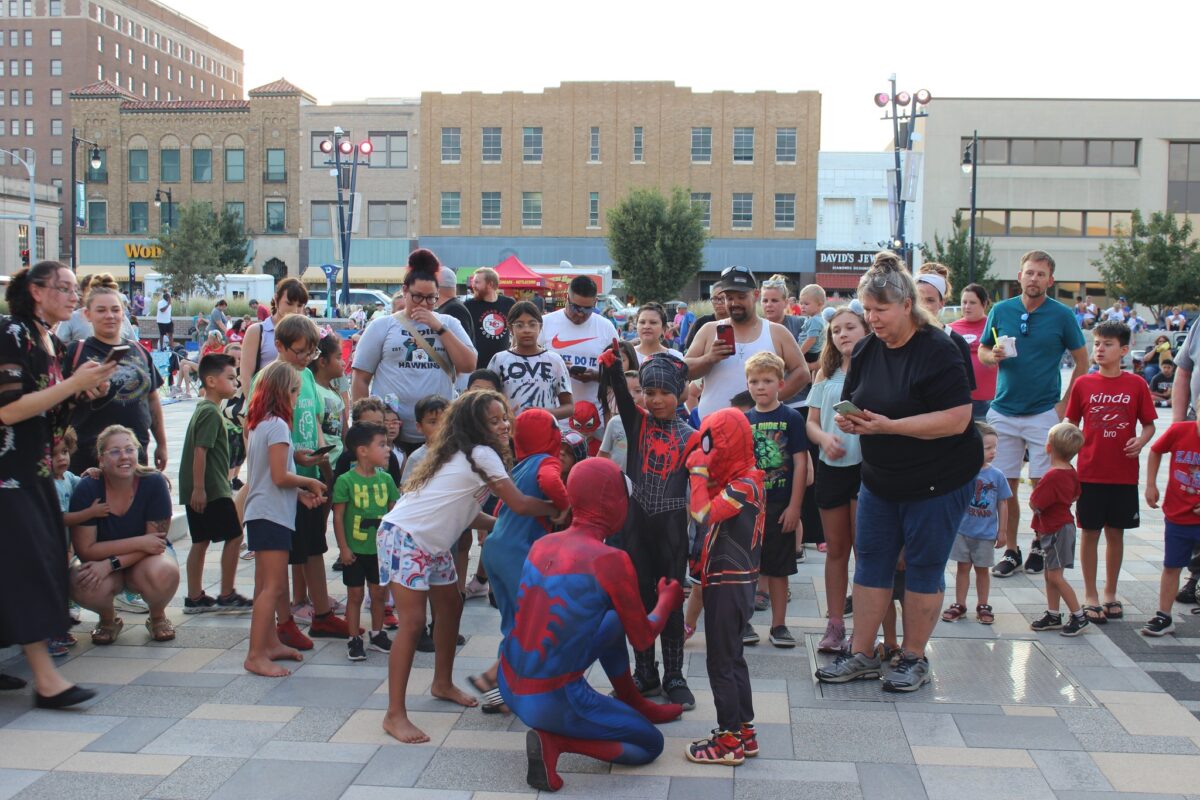
While the economic climate continues to create complexities, data from the Federal Reserve Bank of Cleveland highlight a net migration away from high-cost, large metro areas compared to pre-pandemic levels. Cities such as Nashville, Tenn., have emerged as hot spots, while nearby cities, such as Muscle Shoals, Ala., benefit from overflow when top destinations become cost-prohibitive, Russell said.
Though planners in Nashville might point to programming for visitors in the downtown scene as a factor, he added, a decades-long cycle of Nashville serving as fertile ground for budding musicians is probably core to the changes there.
And drilling down on the numbers in areas concerned about losing people paints a potentially surprising picture.
“This is an old Rust Belt story,” Russell said. “There’s a perception of an exodus, and at one time there was. Young folks left and had kids elsewhere. The reality now isn’t one of flight. It’s that, when places are struggling, no one is moving in. Probably more interesting is that they aren’t leaving, either.”
“People move in for opportunity,” he said. “They gain skills and ideas and networks and then move out. In, up, and out.”
The longer-cycle shifts and effects of remote work mean cities may have an opportunity to better position what they have to offer in terms of quality of life, which can include a charming downtown — but city planners can’t forget to focus on investing in existing residents, Russell said.
“If people are leaving, it’s generally because they’re moving to something. I’m not leaving Erie; I’m moving to New York City,” he said. “This is a good moment to be innovative, adaptable, and flexible. Do something to prepare for growth, instead of managing decline.”
The shift to remote work makes one urban planning concept, the 15-minute city, attractive for cities with a built environment in the waiting. Brought to broader light by Paris Mayor Anne Hidalgo in her successful 2020 reelection campaign, the idea is that everything you need, including work, should be within a 15-minute walk or bike ride from home.
“The pandemic broke the tether with work,” Russell said. “If you have your 15-minute city, but you don’t need to have your occupation there, that’s really empowering.”
Metro areas that are stagnating compared to pre-pandemic numbers — such as the Financial District in New York City and Manhattan office markets, where more than 20 percent of offices are vacant — highlight the move away from what had been more single-use spaces, primarily aimed at the 9-to-5 set.
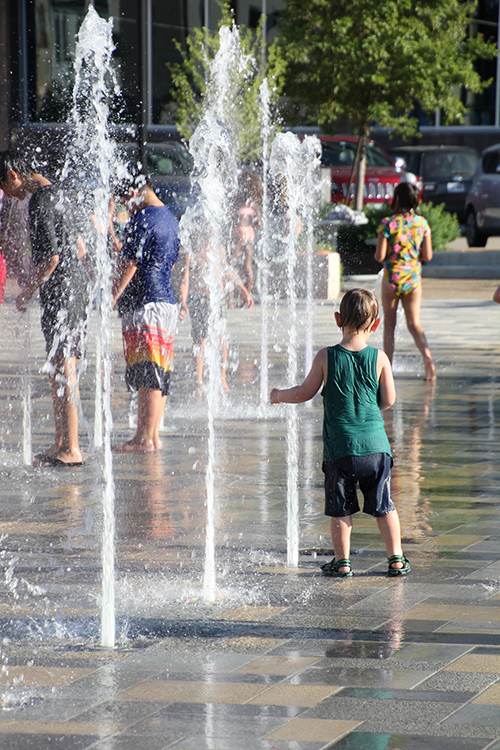
“Shops and other businesses served the workers who commuted there in what was the exact opposite of the 15-minute city,” Russell said. “Places doing really well are where people can live and have everything they need within walking distance, including day care.”
In the midst of the challenges and opportunities, economic development and municipal leaders continue to try to figure out where central business districts fit, a question some cities have been grappling with since the 1950s.
Downtowns organically grew in the first half of the 19th century as industrial hubs. When World War II came to a close and industrial activity slowed, business leaders began to worry about downtowns losing steam.
Now, with many downtown office towers far less populated, the question comes up again. While live, in-person experiences become more of a draw, turning downtown postindustrial places into a recreation destination sometimes arises as a potential solution.
Roger Brooks, CEO of Arizona-based Destination Development Association, has built a career out of trying to prove that an “if you build it, they will come” approach can work. He was working with resorts in the 1980s when he was asked to “fix a town,” and since has served as a consultant for about 2,200 cities and towns.
“One thing I tell people all the time is that there are 19,500 cities and towns (and villages) in the U.S.,” he said. “Almost every one was founded on transportation, natural resources, or both. Out of those, about 17,000 have had to answer this question: What’s our second act?”
His work over the past decades included a survey of 2,000 downtowns in the U.S. and Canada in an effort to find the 400 with the lowest vacancy rates and other traditional markers of success. That seven-year project resulted in a list of factors they had in common, specifics like business hours and the number of days a year that a town square had activities.
“You have to get people downtown on a consistent basis, 250 days a year or more,” Brooks said. “It can’t just be a weekly farmer’s market or a few events.”
One of his frequent suggestions is to create an activity hub in a town square or central park area, akin to the way Frederick’s leaders put the city’s artificial creek to work as a destination.
“I’m a huge believer in programmed plazas,” Brooks said. “For instance, you could have a splash pad that operates 120 days a year and in the winter make it a skating rink for another 120 days a year. There’s 240 of your 250 days.”
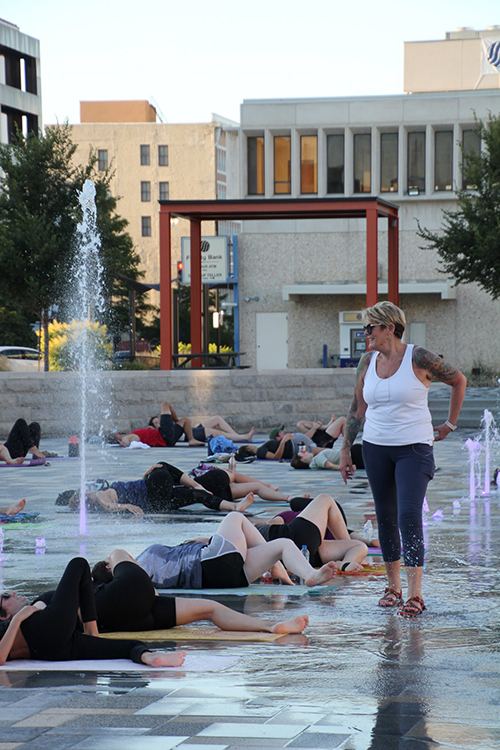
Another city that followed his advice is Topeka, Kan. In 2013, Brooks was the second consultant to suggest a programmed plaza, according to Kurt Young, Downtown Topeka Foundation chairman. This time, city leaders and the city’s business community took action.
With support of the Topeka Lodging Association, the city approved allocating a portion of transient guest taxes, which provided $3.4 million to help fund the effort to build a downtown plaza. The lodging association agreed to add a $1-per-night tax on hotel guest stays, and that funding was earmarked to subsidize the plaza’s daily operation.
Fundraisers reached a $9.6 million goal in six months. The resulting Evergy Plaza was constructed with four main attractions: a 50-foot performance stage, a 30-foot digital video board to show movies, a 16-foot fire pit, and a centerpiece $1.6 million fountain that can serve either as an interactive splash pad or a full-on water show with colored lights and music.
The catch was that construction was completed in March 2020 — right when residents were sent home to curb the pandemic’s spread. (Last year) has become the first year to gauge the plaza’s impact, Young said.
“2022 has been our breakout year,” he said. “Movie nights are well attended. We have weekly lunchtime performances with a band, and food trucks are down there any time we have an event. It’s doing what it was intended to do — bring the community downtown.”
A priority, Downtown Topeka Inc. President Rhiannon Friedman said, is working with local employers to connect with young professionals, as well as taking steps to make sure community members who live in the city’s neighborhood feel welcome at public events, all of which are free.
“Trying to find artists and acts of different cultures has done a good job of bringing people that may have lived here all their lives but never stepped foot in downtown Topeka before,” she said. “It’s been really nice to have this asset that pulls people from different parts of the community.”
The impact on the business community appears to be positive so far, Young said, with around eight new businesses popping up along Kansas Avenue since the community began to open up after the pandemic.
Friedman said downtown life in the state’s capital is taking on a different look.
“This was not traditionally how people interacted with downtown. It’s now more than corporate headquarters — it’s a full experience that’s more of a big-city vibe than the urban sprawl you see in cities like Topeka.”

